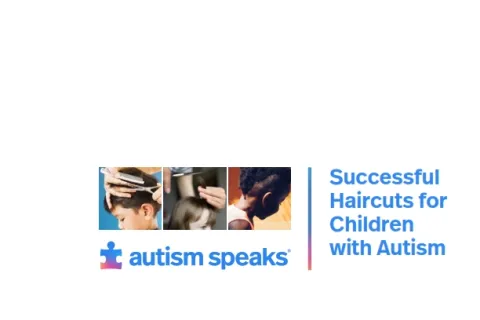Child won't stop snorting
By Dr. Moira PeñaThis answer is by occupational therapist Moira Pena, of Toronto’s Holland Bloorview Kids Rehabilitation Hospital. The hospital is one of 14 centers in the Autism Speaks Autism Treatment Network (ATN).
We’re having difficulties with a new stim [sensory stimulating behavior] that our seven-year-old has developed. He’s snorting. It’s deep and from the back of his throat. It started when he had some sinus drainage. That’s gone, but he still snorts constantly both at home and at school. I suspect he enjoys the vibration it makes. But it sounds terrible, and we’re getting complaints. We have no idea how to curtail or replace this behavior.
Thanks for your question. I suspect that you’re correct in thinking that there is a sensory stimulation element to this new behavior. However, it’s important to first rule out other potential causes with the help of a medical professional. Here are some of the possibilities to investigate:
Could the snorting be due to a medical problem?
Though you mention that your son no longer has obvious sinus drainage, it’s so important for a qualified medical professional to evaluate your son to rule out any persistent physical problem.
Could the snorting be a tic?
By definition, tics are involuntary responses beyond a person’s control. Tics can appear abruptly and take various forms. Familiar examples include facial twitches, compulsive blinking and unusual neck movements. Tics can also have a vocal component such as snorting, sniffling, throat clearing and unusual sounds. Typically, a tic has no clear trigger. The child (or adult) feels a compulsive need to engage in the behavior and typically feels quite frustrated by the inability to stop it. If you or your son’s doctor suspects a tic behavior, a referral to a neurologist may be the next step.
Could the snorting be driven by anxiety?
We know from research that many children with autism also suffer from an anxiety disorder. Repetitive and self-stimulatory behaviors can be a self-soothing response to the stress they feel. From my own practice, I recall a teen with autism who started hiccupping in stressful anticipation of social situations. His hiccupping and other anxiety symptoms only worsened if he tried to stifle the hiccups. If you or your son’s doctor suspects underlying anxiety, a referral to a psychologist or psychiatrist may be in order.
Working with problematic sensory-stimulatory behavior
If you sense that your son simply enjoys the snorting on some level, then it may very well be a pleasurable form of sensory stimulation. As an occupational therapist who specializes in autism, I frequently help children with sensory stimulation behaviors that interfere with their daily lives.
The kind of snorting you describe is both common and particularly challenging to manage. So while I hope my tips are helpful, I want to make clear that they’re no substitute for a personalized therapy program with your son working one-on-one with an occupational, speech or behavioral therapist.
Also please keep in mind that sensory-stimulating behaviors serve an important purpose. From your question, I see you understand the need to find a replacement behavior to meet your son’s sensory needs.
Here are some strategies that may help reduce the frequency and intensity of the snorting:
Track when it happens
I encourage parents to keep a log that notes when and where a problem behavior tends to occur. Important questions that a behavior log can help answer:
- Does the behavior get louder or more frequent during certain times of day? If so, note the time of day when the snorting becomes louder or more frequent. In my experience, the vocalizations tend to become louder when the child is either particularly excited or overwhelmed by some sort of sensory input (too much noise in the classroom, too many people nearby, spinning fans, fluorescent lighting, echoes in the gym and so on). Becoming aware of your son’s triggers gives you the opportunity to minimize them and/or help him prepare to cope with them.
- Are there times of day when your son seldom if ever engages in the behavior? If so, look for clues as to what in the environment might be inhibiting the behavior. I recall, for example, a student who made loud vocalizations during class and lunch breaks. I noticed that it didn’t happen when he sat at a particular table during lunch. I then noticed that the table was near a window at the quieter end of the lunchroom. I worked with his teachers to allow him to sit in this spot at lunch and seat him in a relatively quiet spot near a window in his classroom. This accommodation helped reduce the frequency of his disruptive vocalizations.
- Does he snort more when he’s around other people or by himself? If the snorting is more frequent when he’s alone, it suggests that he’s simply enjoying the pleasurable vibration. By contrast, if it’s more frequent around people, it may be that he’s responding to something stressful or over-exciting about their presence.
- Does the snorting follow or precede any particular activity or request? If so, your son might be using the behavior to avoid something he doesn’t want to do. I’ve often seen this with behaviors so disturbing that they divert the parent or teacher from following through on the request. If this is the case, it’s important for you to keep your son on task (i.e. time to turn off the video game) while calmly ignoring the behavior.
Awareness training
Some children don’t realize that they’re engaging in a disruptive behavior such as snorting. Or they don’t realize how disturbing it is to other people. If you suspect this is the case, you have several options to increase your son’s awareness:
- A cell phone video clip recording might be a way to show him what his snorting sounds like and looks like. Show the video in private and in a sensitive manner so that your son won’t feel embarrassed. An added option here: Offer to give your son the audio to replay – in privacy – when he wants. Just listening to the sound instead of producing it himself may be an important first step to decreasing or stopping the behavior.
- Make a video enactment that conveys how the behavior upsets other people. For instance, the sound of the snort could be followed by you or another family member putting your hands over your ears with an exaggerated grimace. Show this video to your son and use simple language (such as “Please no snorting. It hurts.”) to show him what you mean.
- Create a simple, illustrated story. It might start with a boy much like your son starting to snort habitually. Told from the boy’s point of view, the story describes (and shows) the boy realizing that his noises disturb his family and classmates. It shows him learning to snort more quietly or finding a replacement behavior (more on that below) to resolve the situation and restore peace.
- Download a set of free Autism Speak Personalized Story Templates, developed with the University of Washington READI lab. I recommend sharing the social story with your son several times a day. You can discuss how the boy in the story feels at different stages of his journey – and how his family and classmates feel, too.
Toning down the behavior and finding substitutes
Here are some tips for finding a replacement behavior to meet your son’s need for sensory input and/or turning down the volume and frequency of his snorting.
- Have your son listen to gentle music or white noise through earbuds or headphones to see if this reduces the frequency of his snorting. The idea is to block the sensory feedback that the snorting provides – while providing an alternative form of feedback.
- Give your son a vibrating sensory toy as a substitute for the vibratory sensory stimulation he’s getting from the snorting. I’ve had success with this method in my practice.
- Help turn down the volume. With help, your son may be able to reduce the intensity of his snorting enough that he doesn’t disturb others but still gives him the sensory input he craves. Many people on the autism spectrum respond best to visual prompts. So I suggest making a “volume-meter” (image at right) to prompt him. Make a game out of seeing just how quietly he can snort.
- Reward abstinence! Praise your son and reward him when he refrains from snorting. Whenever you notice him not snorting, praise him and give him a reward. (The reward can be a check mark on a visual reward chart that add up to earn a toy, treat or favorite activity.) Make your praise and reward exciting enough that he’s motivated to start reducing the behavior without prompting.
- Make a “remote control” to “change the channel.” Use cardboard and colorful markers to create a pretend remote control with one button labeled “change channels.” (See example at right.) The parent shows the child the device and explains that when the parent (or teacher) presses the “change channel” button, the child needs to do something else – in this case something other than snorting. I’ve had great success with this strategy and have shared it with many families. Remember to praise and reward your son for complying.
- Make time for snorting. Encourage your son to indulge in his snorting at specific times and/or places (i.e. the privacy of his bedroom). You might note this regularly scheduled “sensory time” on a visual schedule of the day’s activities. You can learn more about creating a visual schedule in the Autism Speaks visual supports guidebook described below.
- Enrich the day with acceptable, sensory-rich activities. Occupational therapists often refer to this as enriching a person’s “sensory diet.” The idea is to satisfy your son’s need for sensory stimulation in acceptable ways. Options can include bouncing on a therapy ball, playing tug of war, bicycling, swimming, squishing him safely and playfully in a beanbag chair and so on. Find out what your child enjoys and look for opportunities to engage in these activities throughout the day.
- Track what works. With all these activities, track whether the strategy prompts a reduction in the frequency and/or intensity of the unwanted behavior. The behavioral log mentioned above is an excellent tool for this.
I hope these tips and insights prove helpful.
Also see these advice posts by Moira Pena:
- Learn more about visual supports in the Autism Speaks ATN/AIR-P Visual Supports Tool Kit.
- Autism dilemma: Why is teen chewing on clothes, swallowing objects?
- Autism and mealtime: A therapist’s top ten tips for success
- Parent seeks advice: Child with autism eats only candy & chips
You can contact the Autism Speaks Autism Response Team (ART). ART members are specially trained to connect families with information, resources and opportunities.
Editor’s note: The above information is not meant to diagnose or treat and should not take the place of personal consultation, as appropriate, with a qualified healthcare professional and/or behavioral therapist.













